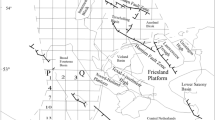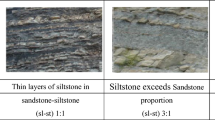Summary
Use of mathematical statistics methods for description of sets of joints in rocks is put forward in this paper. The determination of the presence of a set of joints is performed with the help of the χ2-criterion. The azimuth and angles of dip of joints are considered to be distributed in conformity with the normal law. Mathematical expectations and dispersions of azimuths and dip angles are the parameters of a set of joints to be determined; these parameters being found, the ellipses of dispersion are plotted. These ellipses control the location and configuration of existing sets of joints. The method proposed not only reveals, with required degree of reliability, the presence of a set of joints but also allows the determination of all the quantitative characteristics of joints.
Résumé
Dans le rapport, il est proposé d'utiliser, pour la description de systèmes de fractures, une méthode de statistique mathématique. Il est prévu de vérifier la présence de systèmes de fractures en utilisant le critère χ2. Les directions et les pendages des fractures sont supposés être répartis suivant la loi normale. Les paramètres déterminants des systèmes de fractures sont les espérances mathématiques et les dispersions des directions et des pendages qui déterminent le lieu et les configurations des systèmes de fractures. La méthode proposée permet, avec un degré de certitude, nécessaire, non seulement de révéler l'existence de systèmes de fractures, mais aussi de déterminer les caractéristiques quantitatives de ceux-ci.
Similar content being viewed by others
References
KNORING L. D. (1968): O Svyazi Napravleniy Treschin s Elementami Tektonicheskih Struktur (Relationship between Joint Orientation and Tectonic Structure Elements). Problemi Matematicheskoi Geologii, “Nauka”, Leningrad, 45–67.
LATTMANN L. H.—SEGOVIA A. V. (1961): Analysis of Fracture Trace Pattern of Adak and Kadalaska Island, Alaska. Bull. Amer. Assoc. Petrol. Geol., 45, no. 2, 249–251.
MARANHÃO N. (1974): Geometrical Characterization of Jointing of Rock Masses. 2nd Int. Congress of the IAEG, São Paulo, VI.3.1–VI.3.10.
MCMAHON B. K. (1971): A Statistical Method for the Design of Rock Slopes. 1st Australia-New Zealand Conference on Geomechanics, Melbourne 1, 314–321; 2, 559.
MCMAHON B. K. (1974): Design of Rock Slopes against Sliding on Pre-existent Fractures. 3rd Congress of the ISRM, Denver (USA), II-B, 803–808.
VENTZEL E. S. (1969): Teoria Veroyatnosti (Probability Theory). “Nauka”, Moscow, 576 pp.
VISTELIUS A. B. (1958): Strukturnie Diagrammi (Structural Diagrams). USSR Academy of Sciences, Moscow-Leningrad, 157 pp.
ZANBAK C. (1977): Statistical Interpretation of Discontinuity Contour Diagrams. Int. J. Rock Mech. Min. Sci. and Geomech. Abstr., 14, no. 3, 111–120.
Author information
Authors and Affiliations
Rights and permissions
About this article
Cite this article
Gaziev, E.G., Tiden, E.N. Probabilistic approach to the study of jointing in rock masses. Bulletin of the International Association of Engineering Geology 20, 178–181 (1979). https://doi.org/10.1007/BF02591275
Published:
Issue Date:
DOI: https://doi.org/10.1007/BF02591275




